Last updated: June 23, 2023
Article
King Salmon’s Surprise Reign in Muir Woods
A record-breaking storm drew dozens of huge, spawning fish into a small creek at the heart of Muir Woods. They unleashed a flood of questions.
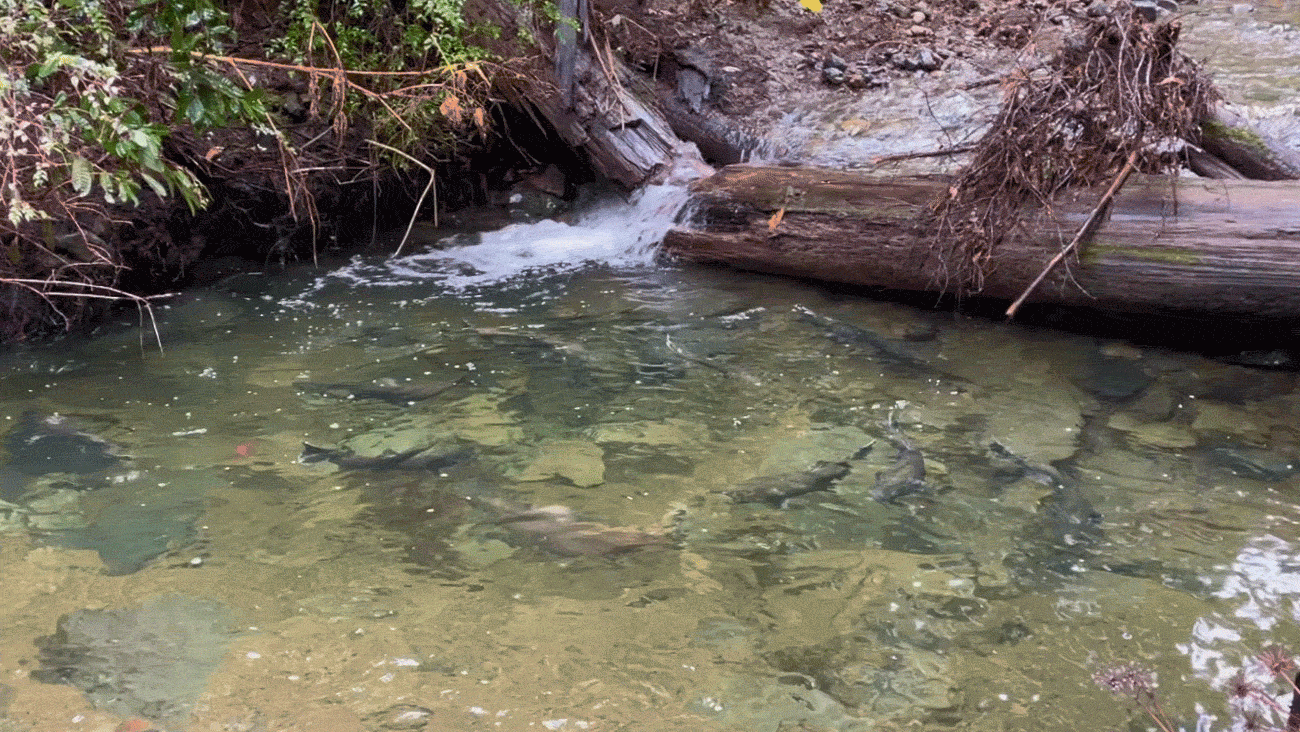
Image credit: NPS / Natale Urquhart
For the past couple of decades, the National Park Service has worked hard to monitor and conserve two struggling salmonids—coho and steelhead—in Muir Woods National Monument’s Redwood Creek. Now scientists in the park have an added challenge: figuring out what it means to have a third salmonid—Chinook (or king) salmon—suddenly join the party.
It all began on October 24, 2021, when a record-shattering amount of rain fell along the central California coast. “We were coming off an extreme drought,” recalled National Park Service Fisheries Biologist Michael Reichmuth. “Literally a month beforehand, we’re out there rescuing coho with a lot of Redwood Creek being completely dry. When we saw this weather coming in, the first notion is that this is relief for the coho in the creek.”
But all that rain falling when it did also had a far stranger consequence. It drew dozens of Chinook salmon into Redwood Creek to spawn, perhaps for the first time: Chinook are nowhere to be found on Muir Woods’ official species list. Reichmuth and his team are studying this fishy anomaly to understand what it means for the park, the creek, and the fish.

Image credit: NPS / Maritte O’Gallagher
“These Coho Look Weird”
Reichmuth oversees salmonid monitoring in the coastal creeks of Muir Woods, Golden Gate National Recreation Area, and Point Reyes National Seashore. He and his research crew are in the creeks almost year-round, tracking two resident species: federally endangered coho salmon and federally threatened steelhead trout. In the spring, the crew surveys young smolts on their way out to the ocean. In the summer, they study juvenile fish in the creeks. In the winter, they monitor the creeks for adult fish returning from the ocean to spawn.
To make sure they cover the beginning of each spawning season, researchers don’t start spawner surveys at a particular date; they begin whenever there’s enough water in the creeks for the fish to migrate upstream. The October storm, which raised creek levels by six and a half feet almost overnight, kicked off the spawner monitoring season early. But early surveys haven’t yielded much in the past.
“We've done surveys in early November before and haven't found any salmon moving up the watershed to spawn,” explained Reichmuth. “So when we were doing our surveys, I wasn't planning on seeing anything.” What he did see was disorienting. “At first [the fish] were throwing me off a bit, because, you know, my eye was in tune for looking for coho,” he continued. “And when I saw these, I'm like, ‘these coho look weird.’ I don't think it was till later that I realized that no, these aren't coho; they're Chinook.”

Image credit: NPS / Natale Urquhart
Big Fish in a Small Creek
Chinook are the biggest of the Pacific salmon, hence their “king” nickname. They can grow to more than three feet long and over 30 pounds—over a foot longer and more than double the weight of typical coho. The species is present in big creeks and rivers from Central California north to Alaska. But the clipped adipose fins of several of the Chinook that strayed into Redwood Creek indicated they’re probably from the nearby, hatchery-raised Central Valley fall-run population.
The massive Sacramento-San Joaquin River system that these Chinook return to through the mouth of the San Francisco Bay suits their large size. Yet hatchery-raised fish don’t always return to the right place. This is because they have less time to imprint on their natal waterway than their wilder counterparts. Even so, seeing them stray into Redwood Creek came as a big surprise.
Redwood Creek originates on the slopes of Mount Tamalpais, flows through the heart of Muir Woods, and meets the sea less than eight miles north of San Francisco Bay. Although it’s in the right place for Chinook to find it as they migrate south towards the bay, the creek is tiny. At less than five miles long, it’s even small for creeks that support the smaller coho and steelhead. Maybe in this particular case, the high flows from the storm made it seem much more substantial from the Chinook’s offshore perspective. “They're coming into the San Francisco Bay Area, towards the Bay, and then there's this big freshwater influence close by,” Reichmuth ventured. “It might be that a lot of them chose to follow that.”
Game Changer
Once Reichmuth got a photo back to the office and confirmed the fish crew was finding Chinook, not coho, in Redwood Creek, he knew they had more work to do. “I think the game after that changed to really trying to make sure that they are all Chinook salmon,” he said. “So we kept, you know, looking to see if any coho had followed them in.” Yet for weeks, they found only Chinook. Even as coho began arriving in mid-November, they continued seeing Chinook. The crew spotted the last Chinook on December 19, 2021.
Throughout the spawning season, Reichmuth and his crew seized the opportunity to gather as much data as possible. When they found Chinook carcasses, they collected scale and tissue samples. They also returned the snouts of tagged hatchery fish, with their telltale clipped fins, to the California Department of Fish and Wildlife for tag recovery.

Image credit: NPS / Tara Blake
The tissue samples hold genetic information that, once analyzed, will help Reichmuth determine the origin of the hatchery fish. It will also tell where they were released and reveal whether wild fish strayed into Redwood Creek. Since Chinook can return to spawn at three to five years of age, the scale samples will help Reichmuth pin down whether a particular age group was more prevalent in the creek. Meanwhile, California Department of Fish and Wildlife will use the recovered tags to help evaluate hatchery performance.
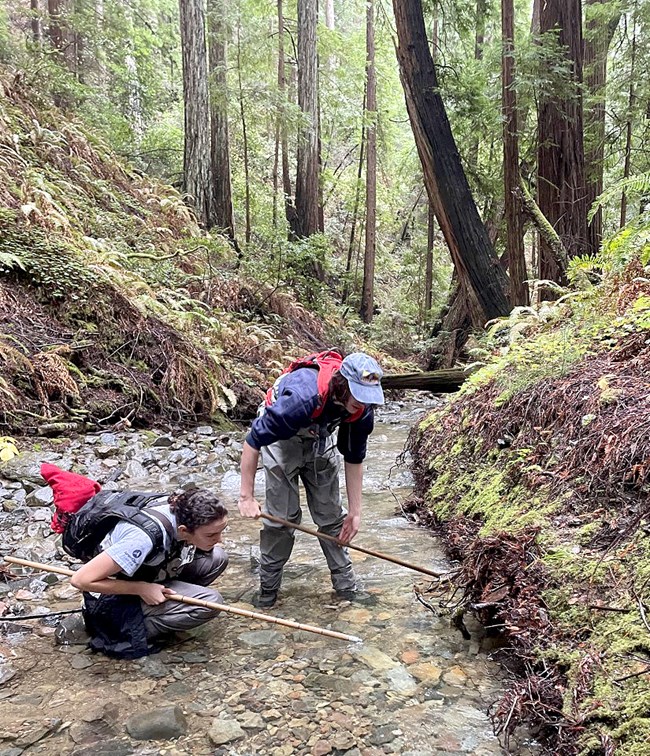
Image credit: NPS / Tara Blake
In total, Reichmuth and his team counted at least 80 individual Chinook and 20 Chinook redds (nests) in Redwood Creek. The crew also found a small number of Chinook in Point Reyes National Seashore’s Olema Creek. Reichmuth still sounds surprised when he reflects on those numbers: “We did survey the other creeks, and there were some Chinook spawning in other creeks too, but not the magnitude that we had on Redwood Creek.”
In Redwood Creek, the straying Chinook far outnumbered the creek’s other returning salmonids. But there were many more male Chinook than females, so their numbers didn’t translate into a similarly higher number of redds. Reichmuth’s team located 19 redds apiece for coho and steelhead, effectively matching the 20 produced by spawning Chinook. They ended the spawning season feeling curious about whether any of the Chinook redds would be successful. They didn’t have to wonder long.
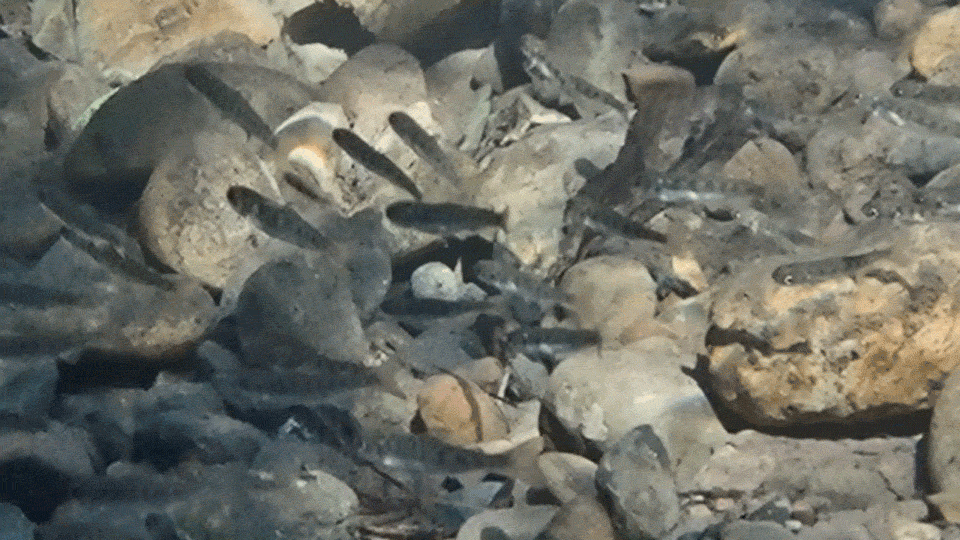
Image credit: NPS / Michael Reichmuth
Tiny Kings Sighted
At the end of the spawner season, the fish crew began snorkel surveys they had already planned for year-old coho and steelhead. That’s when they saw them—tiny, newly hatched Chinook darting around the creek bed. Past research points to one way that the influx of adult Chinook likely benefitted Muir Woods: salmonid carcasses deliver valuable marine-derived nutrients to forest ecosystems, increasing species diversity and tree growth. That’s great news for the park’s towering coast redwood trees that inspire awe and draw in so many visitors. But what are the effects of having young Chinook in the creek?
Without any obvious answers, Reichmuth and his fellow scientists quickly outlined a study examining how the young of all three salmonids—Chinook, coho, and steelhead—behave and interact in the creek. They are collecting underwater video footage in creek pools with and without Chinook to tally all of the fishes’ visible behaviors. They want to know things like what the fish eat, how they find food, and whether they defend their territories. This will help gauge the extent to which the fish compete or coexist. Their results will help the National Park Service understand how to support struggling coho and steelhead populations in a system that also includes Chinook.

NPS / Natale Urquhart
Global Weirding and Precipitation Whiplash
Of course, there is no guarantee that the kings will continue to thrive in Redwood Creek. More monitoring should help resolve that question. The fish crew hopes to count the juvenile Chinook that migrate out to sea during their usual spring coho and steelhead smolt migration monitoring. As Reichmuth explained, this might give them “a better sense of what the likelihood is, given different survival percentages in the ocean, of fish wanting to come back to Redwood Creek.”
Will Chinook return to the creek when they mature in three to five years? Will they be able to? It’s possible that imprinted fish will wait around a little to re-enter their natal creek, but if Redwood Creek doesn’t have enough water in the fall, they’ll be forced to move on to other waterways.
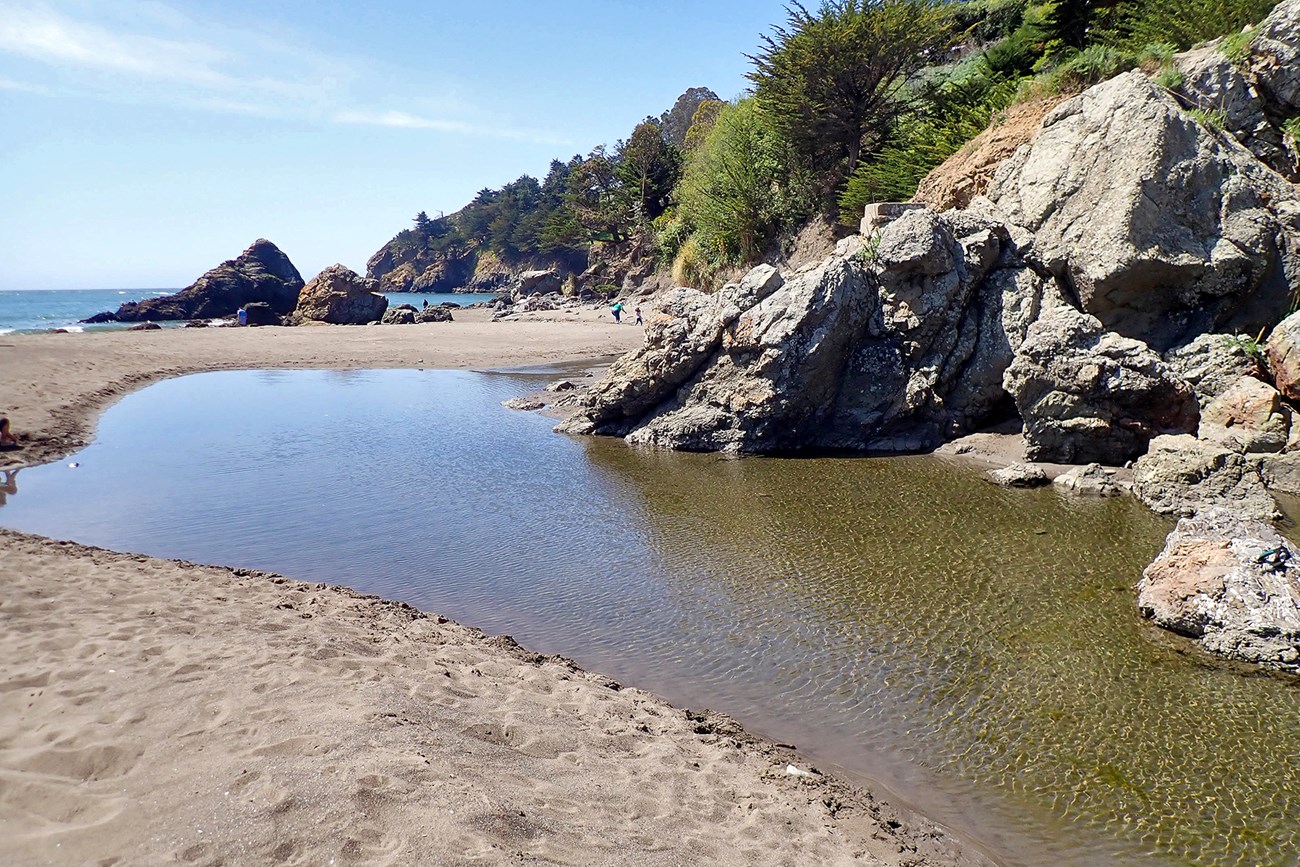
Image credit: NPS / Brentley McNeill
The storm that brought Chinook to Redwood Creek exemplifies what some describe as global “weirding,” the kind of extreme weather that’s becoming more frequent, courtesy of climate change. California’s brand of global weirding, “precipitation whiplash,” describes this event even more accurately, given the extreme drought that preceded the extreme storm. The typical start to California’s rainy season now falls in December, almost a full month later than it once did. It’s possible that another precipitation whiplash event will fill Redwood Creek in the fall. But in a warming California, the Chinook are much more likely to find the creek dry.
Staying Flexible for an Uncertain Future
As we wait for a clearer picture to emerge about the kings’ appearance in Redwood Creek, this event invites us to imagine what else climate change and global weirding might throw our way, and how to learn from it. Reichmuth learned that having a flexible, year-round team is most valuable for staying on top of such events. A seasonal fish crew may not have been able to monitor more fish for a solid month longer than normal, as they needed to do in this case. The long-term nature of the salmonid monitoring program, with more surveys always on the horizon, is also important. The young Chinook that hatched in Redwood Creek this year, for instance, will need three to five years to mature in the ocean. We will have to wait for the results of the Muir Woods spawner surveys in 2024–2026 to find out if any of them will beat the odds and make it back.
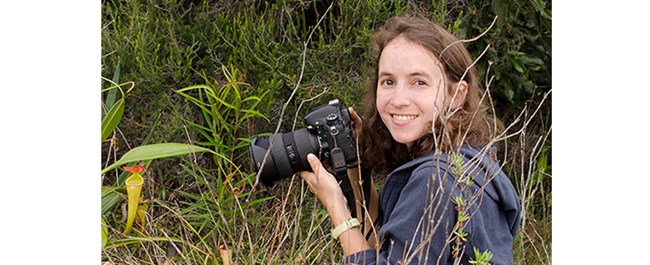
About the author
Jessica Weinberg McClosky is a science communications specialist with the San Francisco Bay Area Inventory & Monitoring Network. She’s often working on either a new story map or a new issue of the San Francisco Bay Area Nature & Science Monthly Newsletter/Blog. Outside of work, Jessica enjoys nature photography and exploring new hiking trails with her family. Photo courtesy of David McClosky.
